|
|
Cairo's Makattam area: a cave church and a garbage city
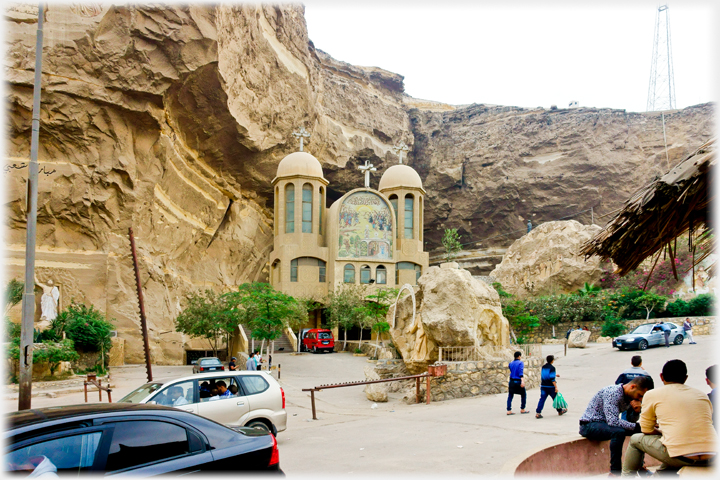 The entrance to the church of St Simon; here taxis ply and kiosks offer their services
The Makattam Hills come close to the centre of Cairo. They house two contrasting features of the city: within a large cave lies the Church of St Simon the Tanner; and to reach this church the visitor passes through Zabbaleen 'village' built in an old quarry by the hillside. This is Cairo's re-cycling quarter, Zabbaleen literally means 'garbage people'.
The entrance to the church of St Simon; here taxis ply and kiosks offer their services
The Makattam Hills come close to the centre of Cairo. They house two contrasting features of the city: within a large cave lies the Church of St Simon the Tanner; and to reach this church the visitor passes through Zabbaleen 'village' built in an old quarry by the hillside. This is Cairo's re-cycling quarter, Zabbaleen literally means 'garbage people'.
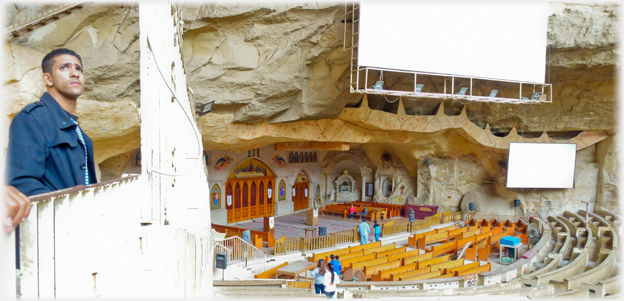 The congregation sits in great banks of seats looking down on the chancel. Above which screens allow for projection; a modern twist to the oldest form of church
The congregation sits in great banks of seats looking down on the chancel. Above which screens allow for projection; a modern twist to the oldest form of church
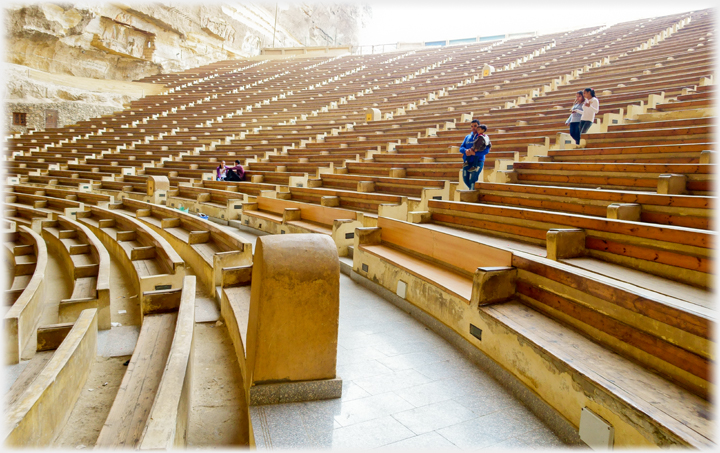 The amphitheatre, formed by the cave, accommodates over 20,000 people
The amphitheatre, formed by the cave, accommodates over 20,000 people
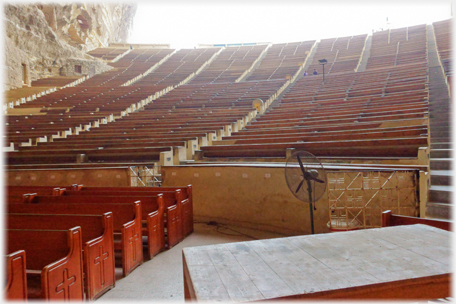 The banks of wooden benches must seem daunting to new clergy who come to serve in this Coptic Church
The banks of wooden benches must seem daunting to new clergy who come to serve in this Coptic Church
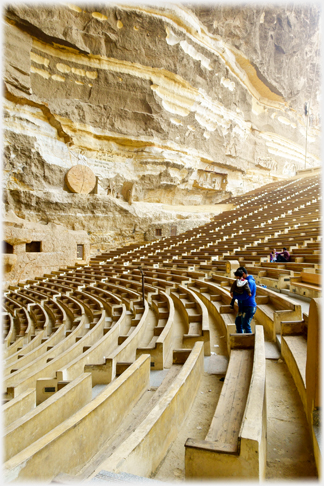 The striations of the geological formation of the Makattam Hills under which the church sits
The striations of the geological formation of the Makattam Hills under which the church sits
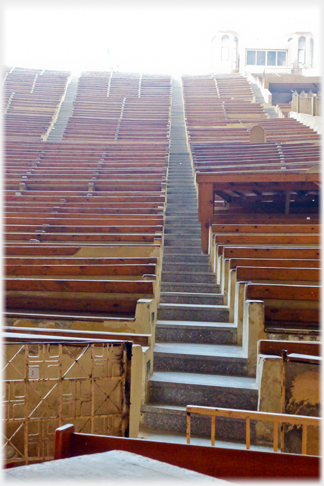 An aisle with 80 rows, allowing seating for over 200 people in each row
An aisle with 80 rows, allowing seating for over 200 people in each row
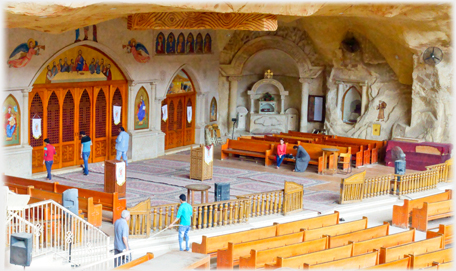 The focal area of a Coptic church is the chancel where there are seats for the deacons and two lecterns. At its rear is the Iconostasis, this is a rigid wood and marble screen with icons of Christ, angels and saints, and three doors (here one out of sight to the left) leading on to the sanctuary beyond
The focal area of a Coptic church is the chancel where there are seats for the deacons and two lecterns. At its rear is the Iconostasis, this is a rigid wood and marble screen with icons of Christ, angels and saints, and three doors (here one out of sight to the left) leading on to the sanctuary beyond
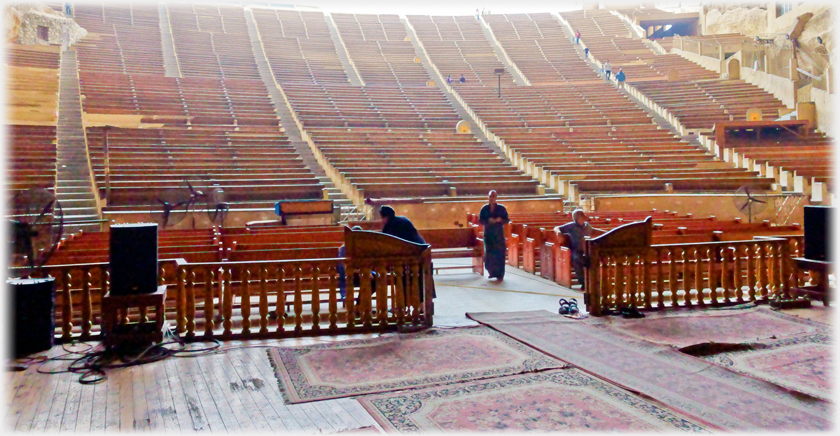 The view across the chancel 'fence' which separates the congregation from the celebrants...
The view across the chancel 'fence' which separates the congregation from the celebrants...
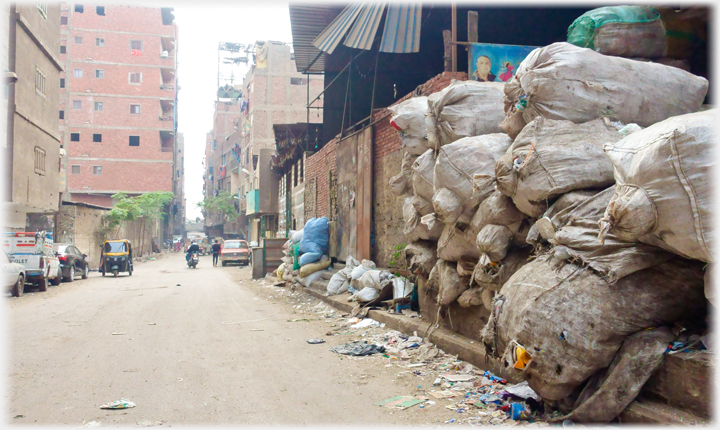 ...and the view of the road, on the way up to the church, seen by the arriving visitor. This is Mokattam Village, also known as 'Garbage City', where some 30,000 Coptic Christians live, many of whom make their living from re-cycling waste materials they gather in Cairo
...and the view of the road, on the way up to the church, seen by the arriving visitor. This is Mokattam Village, also known as 'Garbage City', where some 30,000 Coptic Christians live, many of whom make their living from re-cycling waste materials they gather in Cairo
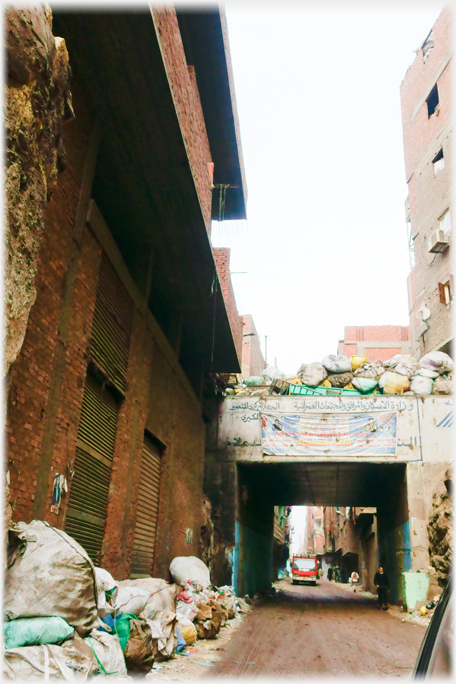 The sheer amount of rubbish on display is extraordinary. Sacks of waste are pilled into every available corner
The sheer amount of rubbish on display is extraordinary. Sacks of waste are pilled into every available corner
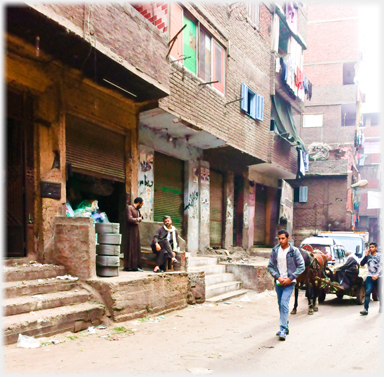 Donkey carts, just visible to the right, are still used for collecting waste from the city, brought to the village, the waste is sorted, sold on, and organic matter feed to animals. It is claimed that over 80% of all material is re-cycled
Donkey carts, just visible to the right, are still used for collecting waste from the city, brought to the village, the waste is sorted, sold on, and organic matter feed to animals. It is claimed that over 80% of all material is re-cycled
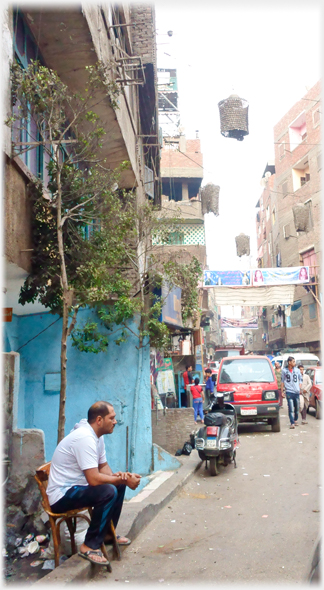 Photographs from other angles show the suburb as a normal working community
Photographs from other angles show the suburb as a normal working community
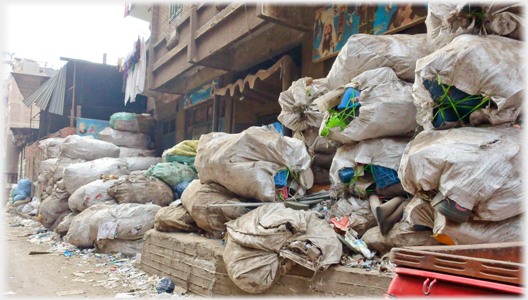 The prospect of the summer heat seems rather unedifying
The prospect of the summer heat seems rather unedifying
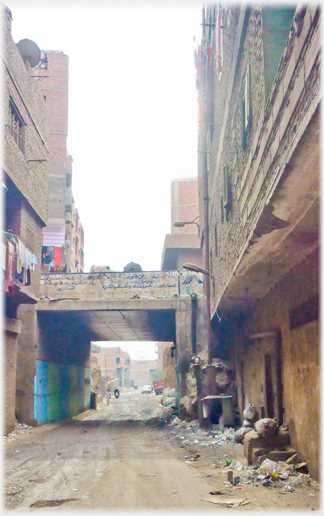 The buildings are new
The buildings are new
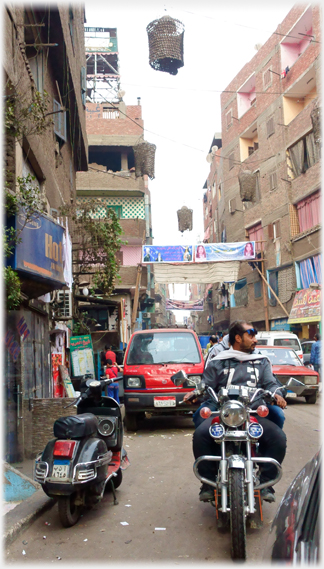 Probably over 90% of the people of Makattam are Coptic Christians
The Zabbaleen people had migrated to Cairo and settled in the Giza district, but in 1970 they were evicted and moved to temporary accommodation in an old quarry area close to the Mokattam hills. In due course their shacks have been replaced by permanent buildings
Probably over 90% of the people of Makattam are Coptic Christians
The Zabbaleen people had migrated to Cairo and settled in the Giza district, but in 1970 they were evicted and moved to temporary accommodation in an old quarry area close to the Mokattam hills. In due course their shacks have been replaced by permanent buildings
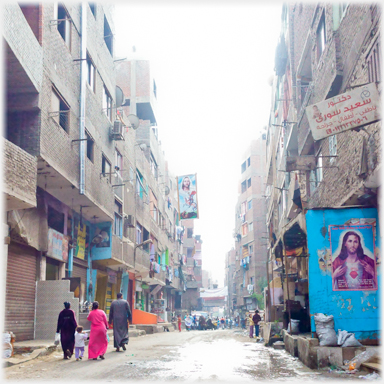 Apart from the large posters of Christ which pop out from between the Arabic lettering on the buildings...
Apart from the large posters of Christ which pop out from between the Arabic lettering on the buildings...
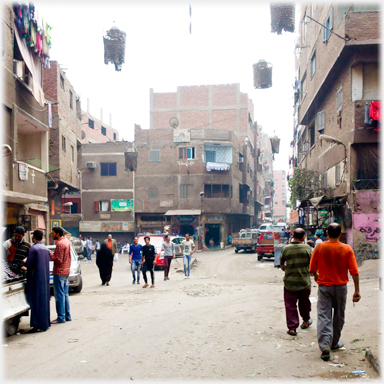 ...Makattam can look much like any other less affluent quarter of Cairo
The next page takes
you from a cave church and garbage city, to jewels in the crown of Cairo's architecture: two of the mosques on the Citadel complex.
...Makattam can look much like any other less affluent quarter of Cairo
The next page takes
you from a cave church and garbage city, to jewels in the crown of Cairo's architecture: two of the mosques on the Citadel complex.
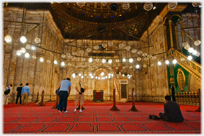

Saturday 20th May 2017

Go to the Picture Posting contents page
Return to the top
|
|
 The entrance to the church of St Simon; here taxis ply and kiosks offer their services
The Makattam Hills come close to the centre of Cairo. They house two contrasting features of the city: within a large cave lies the Church of St Simon the Tanner; and to reach this church the visitor passes through Zabbaleen 'village' built in an old quarry by the hillside. This is Cairo's re-cycling quarter, Zabbaleen literally means 'garbage people'.
The entrance to the church of St Simon; here taxis ply and kiosks offer their services
The Makattam Hills come close to the centre of Cairo. They house two contrasting features of the city: within a large cave lies the Church of St Simon the Tanner; and to reach this church the visitor passes through Zabbaleen 'village' built in an old quarry by the hillside. This is Cairo's re-cycling quarter, Zabbaleen literally means 'garbage people'.
 The congregation sits in great banks of seats looking down on the chancel. Above which screens allow for projection; a modern twist to the oldest form of church
The congregation sits in great banks of seats looking down on the chancel. Above which screens allow for projection; a modern twist to the oldest form of church
 The amphitheatre, formed by the cave, accommodates over 20,000 people
The amphitheatre, formed by the cave, accommodates over 20,000 people
 The banks of wooden benches must seem daunting to new clergy who come to serve in this Coptic Church
The banks of wooden benches must seem daunting to new clergy who come to serve in this Coptic Church
 The striations of the geological formation of the Makattam Hills under which the church sits
The striations of the geological formation of the Makattam Hills under which the church sits
 An aisle with 80 rows, allowing seating for over 200 people in each row
An aisle with 80 rows, allowing seating for over 200 people in each row
 The focal area of a Coptic church is the chancel where there are seats for the deacons and two lecterns. At its rear is the Iconostasis, this is a rigid wood and marble screen with icons of Christ, angels and saints, and three doors (here one out of sight to the left) leading on to the sanctuary beyond
The focal area of a Coptic church is the chancel where there are seats for the deacons and two lecterns. At its rear is the Iconostasis, this is a rigid wood and marble screen with icons of Christ, angels and saints, and three doors (here one out of sight to the left) leading on to the sanctuary beyond
 The view across the chancel 'fence' which separates the congregation from the celebrants...
The view across the chancel 'fence' which separates the congregation from the celebrants...
 ...and the view of the road, on the way up to the church, seen by the arriving visitor. This is Mokattam Village, also known as 'Garbage City', where some 30,000 Coptic Christians live, many of whom make their living from re-cycling waste materials they gather in Cairo
...and the view of the road, on the way up to the church, seen by the arriving visitor. This is Mokattam Village, also known as 'Garbage City', where some 30,000 Coptic Christians live, many of whom make their living from re-cycling waste materials they gather in Cairo
 The sheer amount of rubbish on display is extraordinary. Sacks of waste are pilled into every available corner
The sheer amount of rubbish on display is extraordinary. Sacks of waste are pilled into every available corner
 Donkey carts, just visible to the right, are still used for collecting waste from the city, brought to the village, the waste is sorted, sold on, and organic matter feed to animals. It is claimed that over 80% of all material is re-cycled
Donkey carts, just visible to the right, are still used for collecting waste from the city, brought to the village, the waste is sorted, sold on, and organic matter feed to animals. It is claimed that over 80% of all material is re-cycled
 Photographs from other angles show the suburb as a normal working community
Photographs from other angles show the suburb as a normal working community
 The prospect of the summer heat seems rather unedifying
The prospect of the summer heat seems rather unedifying
 The buildings are new
The buildings are new
 Probably over 90% of the people of Makattam are Coptic Christians
The Zabbaleen people had migrated to Cairo and settled in the Giza district, but in 1970 they were evicted and moved to temporary accommodation in an old quarry area close to the Mokattam hills. In due course their shacks have been replaced by permanent buildings
Probably over 90% of the people of Makattam are Coptic Christians
The Zabbaleen people had migrated to Cairo and settled in the Giza district, but in 1970 they were evicted and moved to temporary accommodation in an old quarry area close to the Mokattam hills. In due course their shacks have been replaced by permanent buildings
 Apart from the large posters of Christ which pop out from between the Arabic lettering on the buildings...
Apart from the large posters of Christ which pop out from between the Arabic lettering on the buildings...
 ...Makattam can look much like any other less affluent quarter of Cairo
The next page takes
you from a cave church and garbage city, to jewels in the crown of Cairo's architecture: two of the mosques on the Citadel complex.
...Makattam can look much like any other less affluent quarter of Cairo
The next page takes
you from a cave church and garbage city, to jewels in the crown of Cairo's architecture: two of the mosques on the Citadel complex.


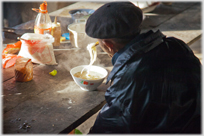 The last page was about making phở (noodle soup) in Vietnam
The last page was about making phở (noodle soup) in Vietnam
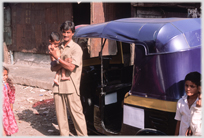 Another community that makes its living from re-cycling - Chambur near Mumbai
Another community that makes its living from re-cycling - Chambur near Mumbai
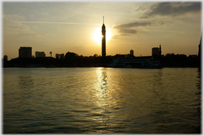 A page on Cairo's heart - Tahrir Square and the Nile
A page on Cairo's heart - Tahrir Square and the Nile
